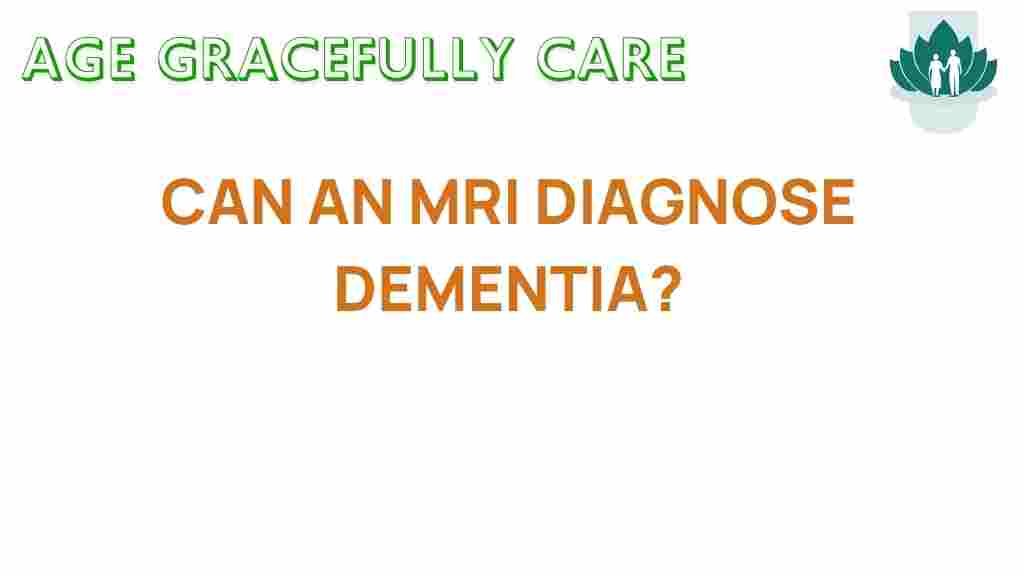Unlocking the Mystery: Can an MRI Truly Diagnose Dementia?
Dementia is a term that encompasses a variety of neurological conditions characterized by cognitive decline, affecting memory, thinking, and social abilities. As the global population ages, the prevalence of dementia is on the rise, making accurate diagnosis essential for patient care. One of the medical technologies employed in the diagnosis of dementia is magnetic resonance imaging (MRI). But how effective is an MRI in diagnosing dementia, and what role does it play in understanding neurological health?
Understanding MRI and Its Role in Diagnosis
Magnetic Resonance Imaging (MRI) is a non-invasive imaging technique that utilizes powerful magnets and radio waves to create detailed images of the organs and tissues inside the body, including the brain. MRI is often utilized in the diagnosis of various neurological conditions, including dementia. Understanding how MRI works and its implications in diagnosing cognitive decline is crucial for both patients and healthcare providers.
- Non-invasive: MRI does not involve radiation, making it a safer option for imaging the brain.
- Detailed Imaging: MRI provides high-resolution images, allowing for the visualization of structural changes in the brain.
- Functional Insights: Advanced MRI techniques can assess brain function and connectivity.
Types of MRI Used in Dementia Diagnosis
There are several types of MRI scans that can be employed to evaluate changes in the brain associated with dementia:
- Standard MRI: This conventional scan provides detailed images of brain structures, helping to identify atrophy or other abnormalities.
- Diffusion Tensor Imaging (DTI): A specialized type of MRI that examines the integrity of white matter tracts in the brain.
- Functional MRI (fMRI): Measures brain activity by detecting changes in blood flow, useful for understanding functional impairments.
- Magnetic Resonance Spectroscopy (MRS): Provides information on the chemical composition of brain tissues, which can reveal metabolic changes associated with dementia.
The Process of Diagnosing Dementia with MRI
The diagnosis of dementia often involves a multifaceted approach, with MRI playing a significant role. Here’s a step-by-step process:
- Initial Consultation: Patients typically begin with a thorough assessment by a healthcare provider, including a review of medical history and symptoms.
- Cognitive Testing: Standardized cognitive tests may be administered to evaluate memory, problem-solving, and language skills.
- Referral for MRI: If cognitive decline is suspected, the healthcare provider may recommend an MRI to visualize potential brain changes.
- MRI Procedure: The patient lies in a scanner for about 30 to 60 minutes. The procedure is painless, though some may feel claustrophobic.
- Interpretation of Results: A radiologist analyzes the MRI images, looking for signs of atrophy, lesions, or other abnormalities indicative of dementia.
- Follow-Up Consultation: The healthcare provider discusses the results with the patient and may recommend further testing or treatment options.
Limitations of MRI in Diagnosing Dementia
While MRI is a powerful tool in diagnosing dementia, it has its limitations:
- Not Definitive: An MRI cannot definitively diagnose dementia; it can only suggest the presence of abnormalities.
- Variability: Brain changes can vary widely among individuals, making interpretation subjective.
- Other Conditions: MRI findings may overlap with other neurological conditions, complicating the diagnosis.
Complementary Diagnostic Tools
To enhance the accuracy of dementia diagnosis, MRI is often used in conjunction with other diagnostic tools:
- Neuropsychological Testing: Comprehensive cognitive assessments provide insights into specific deficits related to dementia.
- Blood Tests: These can help rule out other conditions that may cause cognitive decline.
- Genetic Testing: In certain cases, genetic testing may be recommended, especially if familial dementia is suspected.
Patient Care and Management
Once a diagnosis of dementia is made, patient care becomes a priority. Understanding the role of MRI in the diagnostic process can help families navigate care options:
- Early Intervention: Early diagnosis allows for timely intervention, which may help slow cognitive decline.
- Personalized Care Plans: Knowledge of the specific type of dementia can lead to tailored care strategies.
- Support Services: Various support services, including counseling and caregiving resources, are available to assist patients and families.
Future of MRI in Dementia Diagnosis
Advancements in medical technology continue to enhance the capabilities of MRI in diagnosing and managing dementia. Research is ongoing to improve imaging techniques and develop new biomarkers for better diagnosis:
- AI and Machine Learning: These technologies are being integrated into MRI analysis to improve accuracy and efficiency.
- Longitudinal Studies: Ongoing studies are examining brain changes over time, providing valuable data on the progression of dementia.
- Public Awareness: Increasing awareness about dementia and the importance of early diagnosis is vital for improving patient outcomes.
Troubleshooting Common Concerns About MRI
Patients often have questions or concerns about undergoing an MRI. Here are some common troubleshooting tips:
- Claustrophobia: If you are claustrophobic, inform your healthcare provider. They may offer options such as open MRI machines or sedation.
- Metal Implants: Always disclose any metal implants or devices to the technician, as some may not be compatible with MRI.
- Noise Levels: MRI machines can be loud. Consider bringing earplugs or listening to music if allowed.
- Follow Pre-Scan Instructions: Adhere to any dietary or medication guidelines provided before the scan.
Conclusion
In conclusion, MRI is a valuable tool in the diagnosis of dementia, providing critical insights into brain health and cognitive decline. While it is not a standalone diagnostic tool, it plays a significant role in the comprehensive evaluation of patients suspected of having dementia. As medical technology advances, the potential for MRI to enhance patient care continues to grow. For more information on the intersection of MRI and dementia, refer to this relevant research article.
Ultimately, understanding the capabilities and limitations of MRI in diagnosing dementia is essential for patients and their families. An informed approach to neurological health can lead to better outcomes and improved quality of life for those affected by cognitive decline.
This article is in the category Health and created by AgeGracefullyCare Team
